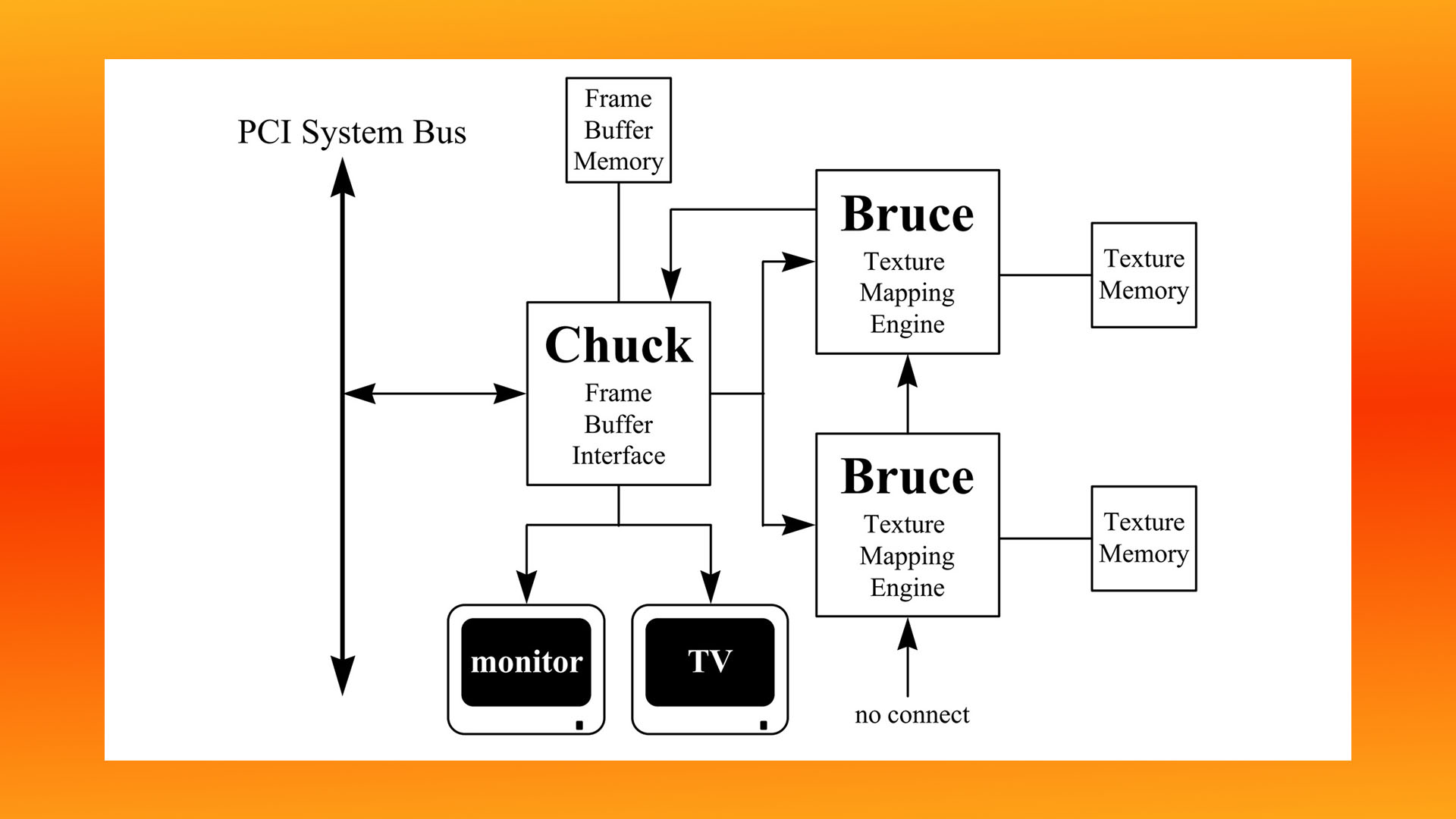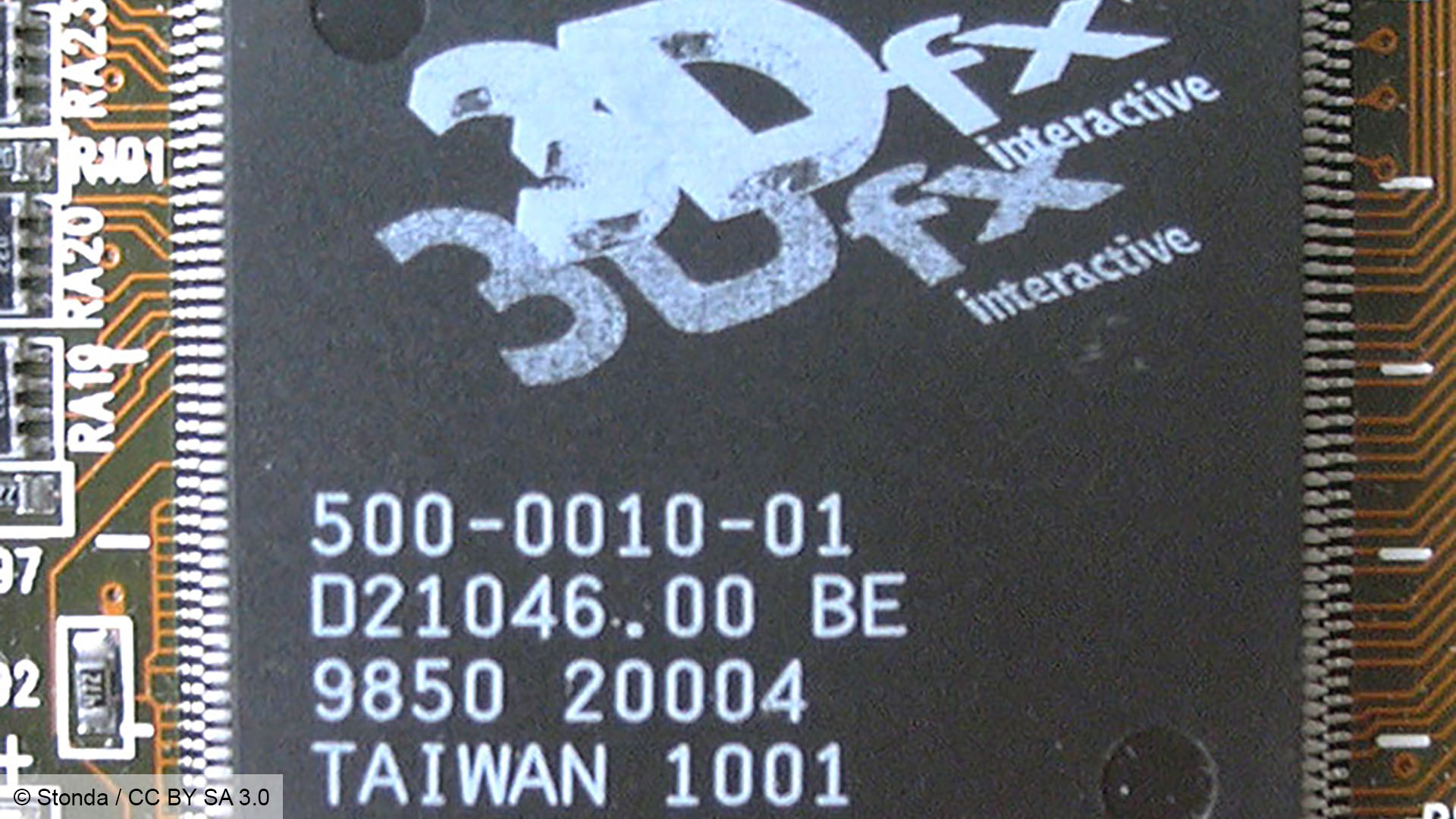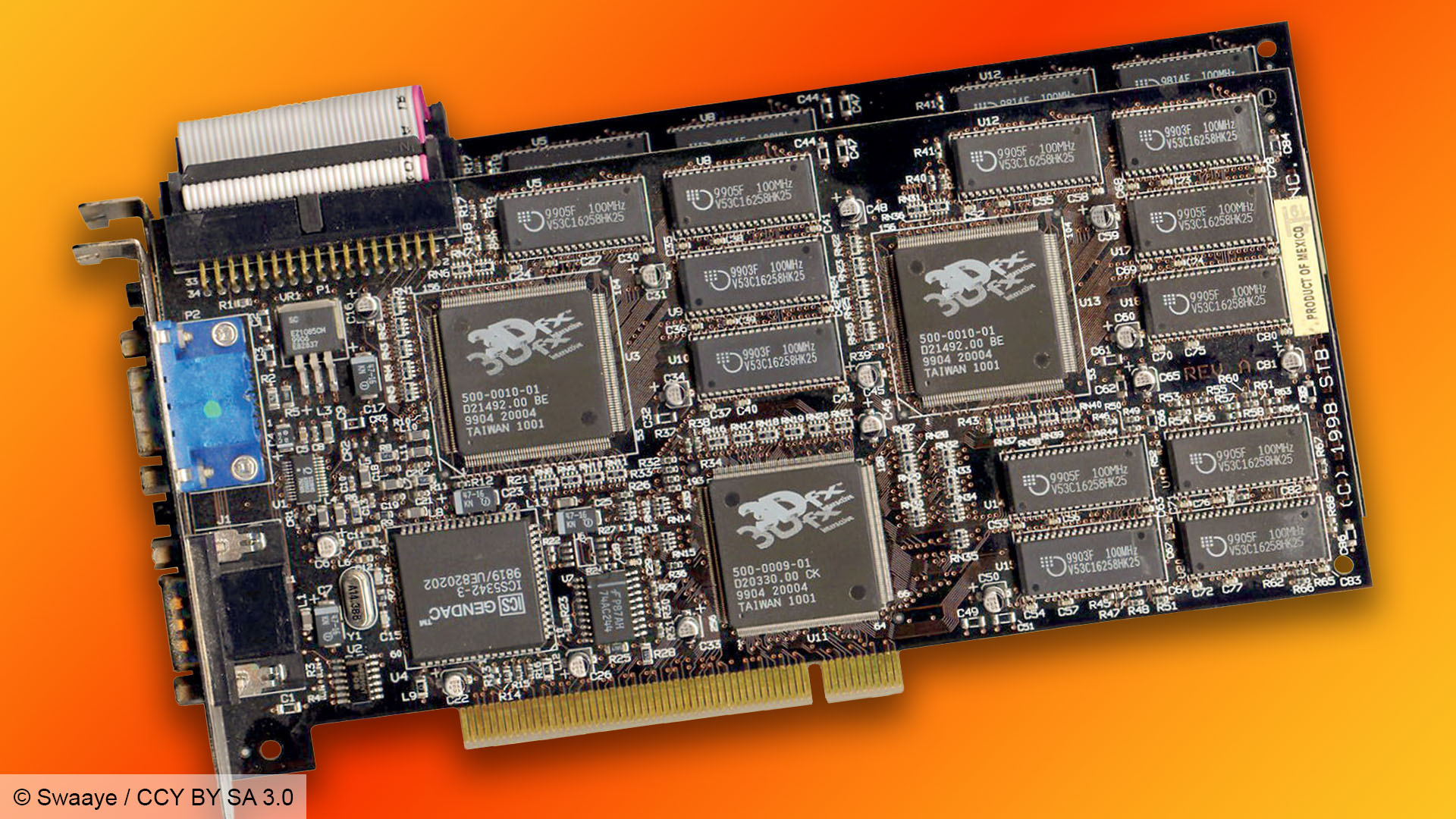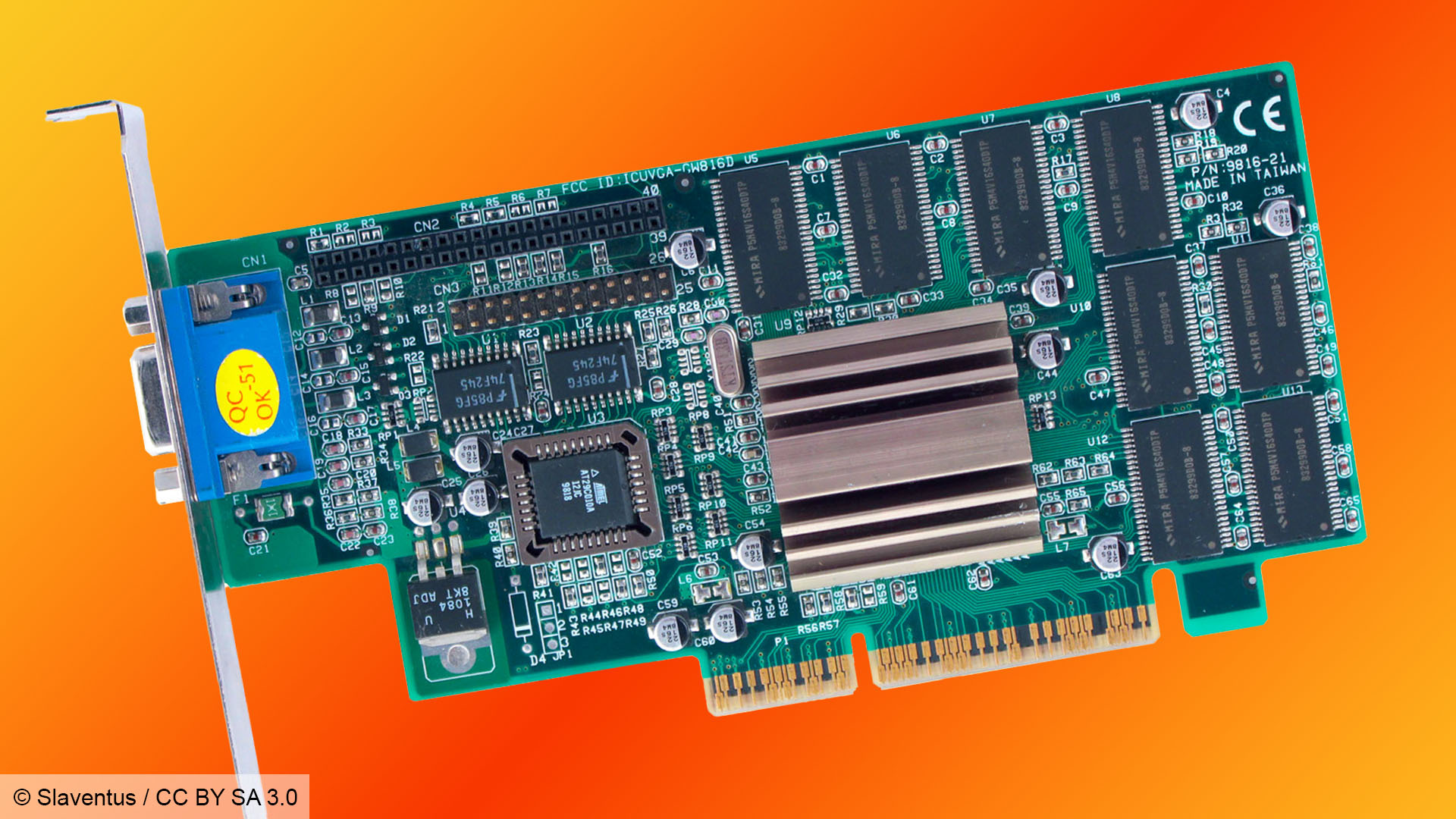Simply how do you observe up a graphics card as beloved, ground-breaking, and simply plain rattling superior as the unique 3dfx Voodoo Graphics? There was, in any case, no technique to repeat that gargantuan leap from the grainy, low-resolution horror of CPU-bound 3D rendering to the smoothness of hardware-accelerated rendering once more, however the 3dfx Voodoo 2 nonetheless managed to keep up that momentum.
Not solely did the Voodoo 2 provide the potential to improve your 3D gaming decision from 640 x 480 to 800 x 600, however in case you paired two of them along with a ribbon cable within the new SLI mode, you would even play video games at 1,024 x 768 (cue sarcastic jaw drop). In the event you performed video games, the 3dfx Voodoo 2 was undoubtedly the very best graphics card of its day.
Whereas it’s tough to think about this as excessive decision in an age the place individuals are sincerely discussing gaming at 7,680 x 4,320, again in 1998 most individuals had been utilizing 14-15-inch CRT screens, a few of which couldn’t even go above 800 x 600 in non-interlaced mode. The concept you would really run 3D-accelerated video games at 1,024 x 768 (786,432 pixels), when the primary 3dfx Voodoo playing cards may solely run at 640 x 480 (307,200 pixels), appeared astonishing.
We’ll come to SLI in a minute, although, because the Voodoo 2 was already benefiting from parallel processing by itself, with out the necessity for a second card.
A part of the rationale why I liked the Voodoo 2 a lot on the time isn’t simply because it was immensely highly effective, but additionally as a result of the playing cards themselves actually seemed like they had been packed to the rafters with silicon. Like early sound playing cards, the PCBs had been coated in chips.
There was both 8MB or 12MB of EDO reminiscence, made up of 256KB chips, usually on both facet of the circuitboard, and there have been additionally three massive chips with fancy 3dfx logos on them, which is the place the magic occurred. Why three? Properly, the Voodoo 2 took the thought of the unique two-chip Voodoo Graphics chipset and parallelized among the work.
Let’s step again and take a look at that first Voodoo Graphics chipset, known as SST1 constructed by TSMC on a 500nm course of. It had two predominant chips – a body buffer interface (FBI) and a texture mapping unit (TMU), every of which had been often allotted 2MB of reminiscence, supplying you with 4MB in whole, though some playing cards gave you extra reminiscence.
The job of the FBI was to take the polygon knowledge out of your CPU, and do the fundamental pre-texturing work – Z-buffering, Gouraud shading, monitoring the polygons, and filling the seen ones with fundamental shading.
Every body would then be cut up into scan traces and despatched to the TMU (or T-Rex as 3dfx known as it), which might apply perspective-correct textures, together with mipmapping (utilizing smaller, less-detailed textures as an object turns into extra distant) and bilinear or trilinear filtering (smoothing out blocky textures when displayed at their largest dimension near the point of view).
3dfx Voodoo 2 chips
The Voodoo 2 then took this identical strategy and ran with it. For starters, it accelerated a bit extra of the 3D graphics pipeline in {hardware}, taking the triangle setup course of away from the CPU.
Secondly, the structure formally had the flexibility to scale with extra texture items being added. The unique Voodoo Graphics commonplace additionally had this potential to scale with further TMUs (it’s detailed within the whitepapers from the time), nevertheless it was by no means used within the gaming playing cards out there within the retailers.
Like SST1, the brand new SST2 chipset (fabricated on a 350nm course of by TSMC) additionally contained an FBI chip codenamed Chuck (denoted by ‘CK’ on the chip) and a texture unit codenamed Bruce (denoted by ‘BE’ on the chip).
A normal Voodoo 2 card would sport one Chuck chip, which did all of the communication with the CPU, carried out the aforementioned triangle setup, and likewise utilized Gouraud shading, alpha mixing, fogging, depth-buffering and dithering. Chuck additionally had its personal 2-4MB allotted chunk of 90MHz EDO reminiscence, addressed by means of a 64-bit interface, and dealt with show controller duties as nicely.
Two Bruce chips would then be hooked as much as Chuck, and as with the T-Rex chip on the unique Voodoo Graphics chipset, these would map the textures to the proper perspective, and course of level-of-detail (LOD) mipmapping, in addition to making use of bilinear or trilinear filtering.

By having two of those chips on one card, you would successfully carry out double the texturing work in a single go, so long as the sport supported a couple of texture layer. Each Unreal and Quake II supported twin texturing per pixel in a single pipeline go, for instance, leading to beneficial properties from the Voodoo 2 in contrast with the unique Voodoo Graphics playing cards.
If the sport didn’t help twin texturing you then’d nonetheless get an honest uplift from the clock pace improve, going from 50MHz on the primary Voodoo to 90MHz on the Voodoo 2, however the distinction wasn’t so pronounced. Having that further chip available additionally successfully gave you the flexibility to allow different options that might in any other case take an excessive amount of of a efficiency hit as a result of variety of passes required.
A major instance is trilinear filtering, which may now be carried out in a single go fairly than two. There was additionally then extra headroom for simulated bump mapping, reflection maps, shadow maps, extra detailed textures and lighting maps. Some video games actually took benefit of this, such because the 1998 sport Battlezone, for which you would obtain a Voodoo 2 patch that gave you some graphical enhanced results, together with extra detailed explosions.
As with Chuck, every Bruce chip had a 64-bit reminiscence interface and its personal allocation of EDO reminiscence. The minimal spec was 2MB per Bruce chip, which might offer you an 8MB card with a 4MB body buffer. There have been additionally playing cards with extra reminiscence – 12MB playing cards, the place every chip had 4MB allotted to it, had been a quite common choice.

3dfx Voodoo 2 SLI
If that further efficiency enhance wasn’t sufficient for you, then you would even go one step additional, and use the little gray ribbon cable that got here in each Voodoo 2 card’s field. This cable enabled you to chain two Voodoo 2 playing cards collectively utilizing the pin headers on the tops of the playing cards.
The 2 playing cards may then share synchronization data with one another over the cable, supplying you with the headroom wanted to run video games at 1,024 x 768, and enabling much more work to be accomplished in a single go, as you now had 4 Bruce chips working collectively.
Though SLI is similar initialism utilized by Nvidia, which purchased out 3dfx and its property in December 2000, for its (now largely defunct) multi-GPU gaming expertise, the unique 3dfx implementation labored fairly in another way. For Nvidia, it stood for ‘scalable hyperlink interface’, the place playing cards labored collectively both on alternate frames or in a cut up display screen mode.
For 3dfx, it stood for ‘scan line interleave’, and it took benefit of the a part of 3dfx’s pipeline in between the Chuck and Bruce chips. Chuck would do the job of splitting every body into scan traces (horizontal chunks of pixels from the left fringe of the scene to the best), after which the Voodoo 2’s pair of Bruce chips would get to work on the texturing work. With two playing cards, nonetheless, they may work in tandem – with one card texturing the even-numbered scan traces, and one card texturing the odd-numbered ones.
Once more, the profit right here wasn’t simply the efficiency enhance, however the potential to course of much more work in a single go. For instance, a single Voodoo 2 may do trilinear filtering with mipmapping in a single go, however would require two passes in case you then added element textures to the combination. Including a second card meant this might all be accomplished in a single go.

SLI was bragging rights expertise, nevertheless it was solely utilized by a choose area of interest of avid gamers, and never solely as a result of shopping for two playing cards was costly. SLI was notoriously fussy when it got here to playing cards working collectively, and the one protected means to make sure compatibility was to purchase two similar playing cards from the identical producer on the identical time.
This lower down your choices for upgrading. In the event you purchased a single Voodoo 2 card at first, upgrading to SLI later would require you to search for an similar card. There have been some exceptions, the place playing cards from completely different producers would cooperate with one another, however there was threat concerned.
Plus, as we talked about earlier, not each sport supported multi-texturing on this means, which meant your two costly playing cards had been generally no sooner than a single one. What’s extra, having two playing cards put a variety of further work on the CPU, which nonetheless dealt with a good quantity of the 3D graphics pipeline presently, together with rework and lighting.
Beforehand, you solely wanted a 1st-gen Pentium CPU to get a 3dfx Voodoo Graphics card working nicely at 640 x 480 in most video games, and formally, the Voodoo 2 had the identical necessities. Nevertheless, SLI upped the stress on the CPU. In 3dfx’s personal exams, a 200MHz Pentium would run Quake 2 at 36fps in SLI mode, however this went all the way in which as much as 67fps in case you had a 300MHz Pentium II – you actually wanted to take away the CPU bottleneck in case you wished to run two Voodoo 2 playing cards.

And there have been extra issues nonetheless, even in case you purchased two similar playing cards. For instance, Artistic’s web site detailed an issue utilizing two Artistic playing cards with a 75Hz monitor refresh charge utilizing the bundled cable. Its recommendation was to both use a single cable or run your monitor at 60Hz as a substitute.
The Voodoo 2 was additionally nonetheless solely a 3D accelerator, which means you additionally wanted a devoted 2D graphics card, which you’d hook up with the Voodoo 2 with a VGA loop-back cable around the again. You continue to solely wanted one loop-back cable for SLI, however when you had two Voodoo 2 playing cards, you had been then utilizing three of your PCI slots for graphics alone.
That’s an issue when most motherboards had few built-in elements, and folks usually had at the least a PCI modem and sound card as nicely. Not solely did an SLI system imply doubtlessly working out of PCI slots, however each enlargement card additionally wanted its personal system assets, and resolving IRQ conflicts with SLI methods was a proper ache.
3dfx Banshee
3dfx did have a solution to the a number of card drawback, with a Voodoo 2-based card that might deal with each 2D and 3D duties, very similar to the earlier Voodoo Rush playing cards had accomplished with the primary Voodoo Graphics, however with only one predominant chip. Referred to as the Banshee (denoted by ‘BAN’ on the chip), it was out there with the brand new Accelerated Graphics Port (AGP) interface, which had began showing on motherboards.
The Banshee successfully mixed the assets of a Chuck chip and a single Bruce chip in a single piece of silicon. It additionally upped the chip clock pace barely to 100MHz, and used 100MHz SDRAM, fairly than the 90MHz EDO reminiscence on the usual Voodoo 2 playing cards.
The dearth of a second texture unit meant the Banshee was considerably slower than the Voodoo 2 in video games that supported twin texturing, however its small clock pace benefit meant the Banshee was very barely faster in different video games.
Nevertheless, concentrating all that processing energy (4 million 350nm transistors) right into a single 137mm² chip made the Banshee a toasty buyer. It got here with a heatsink on the chip as commonplace (some Voodoo 2 playing cards additionally had heatsinks on their chips), however that small heatsink nonetheless turned significantly scorching to the contact – it was nicely price jerry-rigging a small fan to it in case you wished to maintain it in test.
With largely disappointing efficiency, in addition to thermal points, the Banshee struggled to compete with different all-in-one playing cards, such because the Nvidia Riva TNT, in addition to the ATi Xpert playing cards, nevertheless it did lay the inspiration for the single-chip Voodoo3 that appeared later in 1999.
The final devoted 3D card
The Voodoo 2 was a hit for 3dfx, with the flexibility to run video games at 800 x 600, and its improved efficiency, making it extremely in style with avid gamers. At the moment, taking place the 3dfx route was the one means to make sure compatibility with the corporate’s GLide API, which was required by some video games, and likewise generally seemed higher than Direct3D and OpenGL on the time – you would solely get reflective flooring surfaces in Unreal utilizing GLide, for instance.
However the Voodoo 2 was the final of its period – the competitors was busy making 2D/3D combo playing cards, reminiscent of Nvidia’s Riva TNT, and 3dfx later totally joined the membership with its Voodoo3. The age of the devoted 3D gaming accelerator was over, however the Voodoo 2 laid a big a part of the inspiration for parallelizing the 3D graphics pipeline with a number of processors.
Its final gasp got here when 3dfx pulled all of its card manufacturing in home, and rebranded it because the V2-1000, a price range 3D card for individuals who couldn’t afford the Voodoo3, and later Voodoo4 and Voodoo5 playing cards. The ultimate Voodoo 2 whitepaper from 1999 even particulars a model that used SDRAM or SGRAM, fairly than EDO reminiscence, and will function as much as three Bruce chips on a single card – a setup that by no means noticed the sunshine of day.
We hope you’ve loved reminiscing with us by means of this private retrospective in regards to the final 3dfx devoted PCI 3D accelerator. For extra articles in regards to the PC’s classic historical past, try our retro tech web page, and ensure you learn our full information on the way to construct a retro gaming PC, which can take a Voodoo 2 in one in all its PCI slots.

